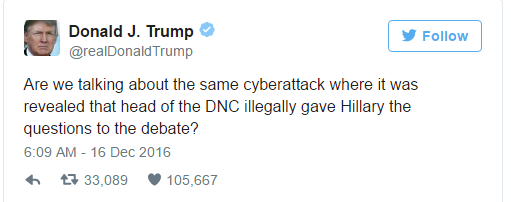
Image Source: NBC News.
The 2016 U.S. election was far from over after November 8th due to the ongoing analysis of Russia’s role in the process. According to The Guardian, American intelligence officials have determined that Russia interfered in the election with the intent to help Donald Trump win the presidential race. Several reports claim that CIA assessments confirmed the interference, and the White House has even labeled Russia’s influence in the election as “fact.” President-elect Trump has denied the Russian involvement.

Below is a summary of what is already known about the Russian interference and what is still up in the air.
1) It’s believed that Russians ordered and hacked the Democratic National Committee (DNC) through phishing.
There’s strong evidence that Democratic email accounts were compromised through phishing messages, which are “designed to steal money.” Microsoft explains the concept as hackers using social engineering to convince victims to install harmful software or reveal personal information. Common clues to determining a phishing email is poor spelling and grammar and the presence of links in the message. Among the phishing emails sent to the DNC was one arriving in Hillary Clinton’s campaign chairman John Podesta’s inbox. When an aide saw the email asking Podesta for a password change, he recognized it as phishing and forwarded it to a computer technician, writing a typo in his own message. “This is a legitimate email,” the aide wrote instead of “illegitimate.” The mistake allowed hackers access to Podesta’s email account.
2) Some malware left on the DNC computers is said to be the same as the software used by hackers with ties to Russian intelligence units.
Researchers tracked the hacks back to the intelligence units codenamed Advanced Persistent Threat (APT), 28/Fancy Bear, and APT 29/Cozy Bear. IP addresses associated with the units were found to connect with the malware. Data left behind also hints at modifications made in Russian language settings. The strongest hint that confirms Russian involvement is likely the fact that some phishing emails were sent via Yandex, a mail provider located in Moscow that runs a prominent Russian search engine. These hacking groups were initially discovered through the use of CrowdStrike, the private cybersecurity firm that the DNC hired for its computer inspection. CrowdStrike reports display that the hackers also accessed the Joint Chiefs of Staff and the State Department.
3) The CIA and the FBI have differing opinions on the supposed hacks.
While both organizations agree that the Russian hack is a possibility, USA Today reports that the FBI needs “a standard of proof that could sustain a possible criminal prosecution.” There have also been disagreements about whether the Russians were trying to support Trump’s win or if the attacks were simply conveyed to show power. However, there is no concern about whether Russians tampered with voting systems, as U.S. voting methods are difficult to interfere with overall.
4) It’s likely that the hackings will be further investigated.
According to CNN, Congress is expected to investigate the Russian involvement more deeply, while Democrats are asking for a declassification of the CIA’s original report. U.S. officials even hint that Russia has continued trying to hack other American organizations. “It’s not like the one-and-done deal here,” said an official. “They continue to engage in this operation around the clock.”
The event has spurred on an order to investigate any other foreign attempts to hack previous U.S. elections. Two Senate committees will investigate the CIA’s report of Russia’s attacks and complete observations before President Obama leaves office in January. While Steve LeVine of Quartz believes that the United States is reluctant to formally respond to the attacks because of fear of “triggering a dangerous, all-out global cyber conflict,” the country is still expected to act in order to tell Vladimir Putin that these attacks won’t be taken lightly.
Sources: The Guardian, Billboard, Microsoft, The Intercept, Quartz, USA Today, CNN
Advertisement
Learn more about Electronic Products Magazine





